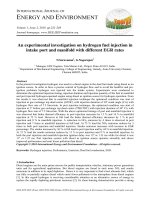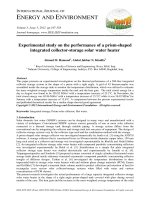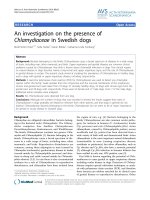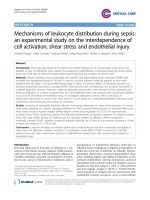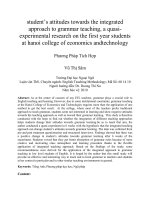Experimental investigation on the applicability of FBRM in the control of batch cooling crystallization
Bạn đang xem bản rút gọn của tài liệu. Xem và tải ngay bản đầy đủ của tài liệu tại đây (1.84 MB, 168 trang )
EXPERIMENTAL INVESTIGATION ON THE
APPLICABILITY OF FBRM IN THE CONTROL OF
BATCH COOLING CRYSTALLIZATION
CHEW, JIA WEI
NATIONAL UNIVERSITY OF SINGAPORE
2006
EXPERIMENTAL INVESTIGATION ON THE
APPLICABILITY OF FBRM IN THE CONTROL OF
BATCH COOLING CRYSTALLIZATION
CHEW, JIA WEI
(B.Eng.(Hons.), NUS)
A THESIS SUBMITTED
FOR THE DEGREE OF MASTER OF ENGINEERING
DEPARTMENT OF CHEMICAL AND BIOMOLECULAR
ENGINEERING
NATIONAL UNIVERSITY OF SINGAPORE
2006
Name
: CHEW, Jia Wei
Degree
: Master of Engineering (Chemical)
Department : Department of Chemical and Biomolecular Engineering
Thesis Title : Experimental Investigation on the Applicability of FBRM in the
Control of Batch Cooling Crystallization
Abstract
Consistent particle properties are an important goal for industrial batch
crystallizations. Several control strategies, from unseeded linear cooling to
seeded supersaturation control, were evaluated for the cooling crystallization of
glycine. Particle properties were assessed in-line using ATR-FTIR, FBRM, and
PVM. Closed-loop supersaturation-control was not superior to open-loop
temperature-control, and seeding was by far the most effective strategy in this
comparison. Unseeded systems do not achieve consistency, because primary
nucleation is unpredictable and do not occur at a fixed temperature. In this work,
the FBRM was successfully used to detect primary nucleation, after which control
strategies were automatically implemented in unseeded cooling crystallization
systems. A novel technique to counter the problem of inconsistent crystal
products due to randomness of primary nuclei was also proposed. This employs
FBRM in a closed feedback loop, which involves adjusting the coefficient of
variance (c.v.) of the primary nuclei. Consistent crystal products from unseeded
systems were hence achievable.
Keywords: batch cooling crystallization, ATR-FTIR, FBRM, feedback loop, PAT
i
Acknowledgements
I would like to thank my advisor, Prof. Reginald Tan, for his patient guidance
and relentless encouragement. I would also like to thank Dr. Ann Chow and Dr.
Simon Black for rendering useful advice throughout this work. Without their
advice and supervision, this work would not have been possible.
My sincere gratitude also goes to my colleagues at the Institute of Chemical
and Engineering Sciences for their valuable technical insights and merry
companionship.
Finally, I want to thank my family and friends for their unconditional love and
support through the years.
ii
Contents
Page
Chapter 1
Introduction
1
Introduction
1
1.1
Motivation and Objective
4
1.2
Thesis Overview
Chapter 2
Background
2
Background
11
2.1
Nucleation
13
2.1.1
Primary Nucleation
14
2.1.2
Secondary Nucleation
16
10
2.2
Metastable Zone
17
2.3
Growth
20
2.4
Control Strategies for Batch Cooling Crystallization
24
Chapter 3
In-Line Monitoring Techniques
3
In-Line Monitoring Techniques
28
3.1
Process Analytical Technology (PAT)
30
3.2
Attenuated Total Reflection – Fourier Transform Infrared
(ATR-FTIR)
34
3.2.1
Principle of ATR-FTIR Technique
36
3.2.2
Chemometrics
40
3.2.3
Applicability of ATR-FTIR to the monitoring and
control of batch crystallizations
43
iii
3.3
Focused Beam Reflectance Measurement (FBRM)
47
3.3.1
Principle of FBRM Technique
48
3.3.2
Applicability of FBRM to the monitoring and control of
batch crystallizations
53
3.4
Particle Vision and Measurement (PVM)
58
Chapter 4
Experimental Methods
4.1
Experimental Set-Up
61
4.2
Calibration for In-Line Solution Concentration Measurement
63
4.3
Solubility Measurements
64
4.4
Metastable Zone Widths (MZW) Measurements
64
4.5
Correlation between CLD and PSD
65
4.6
Temperature-Control (T-control) Crystallization
65
4.7
Supersaturation-Control (S-control) Crystallization
67
4.8
Detection of Primary Nucleation in Unseeded Crystallization
Systems Using FBRM
68
4.9
Feedback Loop employing FBRM in Unseeded Batch Cooling
Crystallization
68
4.10
Investigation on the applicability of the FBRM Feedback Loop
techniques on an alternative system
69
Chapter 5
Results and Discussion
5.1
Overview
71
5.2
Calibration Model
72
5.3
Solubility Curve and Metastable Zone Width (MZW)
Determination
74
iv
5.4
Correlation between CLD and PSD
75
5.5
Case Study 1: Open-Loop Temperature Control (T-control) Seeded
78
5.6
Case Study 2: Open-Loop Temperature Control (T-control) Unseeded
84
5.7
Case Study 3: Closed-Loop Supersaturation-Control (Scontrol) - Seeded
86
5.8
Case Study 4: Closed-Loop Supersaturation-Control (Scontrol) - Unseeded
94
5.9
Comparison between T-control and S-control
94
5.10
Feedback Loop Involving FBRM
97
5.11
Detection of Primary Nucleation in Unseeded Systems Using
FBRM
98
5.12
Case Study 5: Using FBRM in a Feedback Loop to Improve
Consistency in Unseeded Crystallization Systems
102
5.13
Sensitivity Analysis through In-Line Monitoring of the
Crystallization Process using FBRM
109
5.14
Investigation of applicability of FBRM Feedback Loop on
Paracetamol-Water System
113
5.15
FBRM as In-Line Instrumentation in a Closed Feedback Loop
120
5.16
FBRM Data Evaluation (Glycine)
121
5.17
Summary
127
Chapter 6
Overall Conclusion and Future Opportunities
6.1
Conclusions
131
6.2
Future Opportunities
132
References
138
v
Acknowledgements
Contents
Summary
List of Tables
List of Figures
i
ii
vi
viii
ix
vi
Summary
Consistent particle properties are an important goal for industrial batch
crystallizations. Several control strategies, from unseeded linear cooling to
seeded supersaturation control, were evaluated for the cooling crystallization of
glycine. Particle properties were assessed in-line, facilitating assessment of
process consistency. Closed-loop supersaturation-control was not superior to
open-loop temperature-control; and changing the pre-set cooling profile, or the
pre-set supersaturation limit, showed limited benefits. Seeding was by far the
most effective strategy in this comparison. The possible reason for this observed
insensitivity to cooling modes is that crystal growth rates matched the rate of
supersaturation increase for all cooling rates, so that seeded processes operated
entirely within the metastable zone. In contrast, unseeded systems did not
achieve consistency, because primary nucleation is unpredictable and do not
occur at a fixed temperature.
Seeded systems are advantageous in producing consistent crystal products.
However, in view of the constraints on the usage of ports available in the
crystallization vessel, a trade-off exist between using a port for the insertion of an
in-line probe for monitoring of the process or using it for the addition of seeds.
The implementation of in-line instrumentation cannot be over-emphasized, hence
this necessitates a means to internally generate the seeds.
vii
The utilization of Focused Beam Reflectance Measurement (FBRM) probe has
increased tremendously, as evident from the large number of recent publications.
There has yet been any published record of closed-loop feedback technique
involving FBRM. Primary nucleation is unpredictable and does not occur at a
fixed temperature, hence, a means to improve automation of the process through
a closed-loop feedback strategy using the FBRM would be beneficial. In this work,
the FBRM was successfully used to detect nucleation, after which control
strategies were automatically implemented in unseeded cooling crystallization
systems. In addition, the randomness of primary nucleation produces
inconsistent initial nuclei for different runs, thereby resulting in inconsistent
product crystals. A method to counter this problem using FBRM closed-loop
feedback control is also addressed in this thesis, which involves adjusting the
coefficient of variance (c.v.) of the primary nuclei. Consistent crystal products
from unseeded systems were thus achievable.
viii
List of Tables
Table 5-1: Glycine system: FBRM statistics (in the 1-1000 μm range) for final
product crystals obtained from various temperature profiles
implemented on (a) seeded and (b) unseeded systems. ...................83
Table 5-2: Glycine system: Averaged FBRM statistics (in the 1-1000 μm range)
for the CLDs of self-nucleated seeds in eight unseeded experiments.
...........................................................................................................86
Table 5-3: Glycine system: FBRM statistics (in the 1-1000 μm range) for final
product crystals of (a) seeded experiments at two Sset values (0.01
and 0.02 g/g-water), (b) five seeded and (c) five unseeded S-control
performed with Sset = 0.02 g/g-water. ...............................................90
Table 5-4: Glycine system: Duration of cooling temperature ramp and stoppage
temperature upon detection of primary nucleation for various cooling
temperature ramps. .........................................................................110
Table 5-5: Glycine system: FBRM statistics (in the 1-1000 μm range) for initial
CLDs of similar seeds (product crystals in sieve fraction of 125-212
μm) in different masses. ..................................................................123
Table 5-6: Glycine system: FBRM statistics (in the 1-1000 μm range) for initial
CLDs of different seed masses of different sizes.............................126
Table 5-7: Glycine system: Averaged FBRM statistics for various seeding
methods for eight different runs each. .............................................130
ix
List of Figures
Figure 2-1: Modes and Mechanisms in Nucleation .............................................13
Figure 2-2: Schematic of Primary Homogeneous Nucleation .............................15
Figure 2-3: Metastable Zone Width for various types of Nucleation (Ulrich and
Strege, 2001)....................................................................................18
Figure 2-4: Concept of seeded and unseeded batch cooling crystallization
(Fujiwara et al., 2005).......................................................................26
Figure 3-1: Diagram illustrating travel path of ray of light....................................38
Figure 3-2: Schematic Diagram of FBRM Probe Tip...........................................50
Figure 3-3: Chord length measurements ............................................................51
Figure 3-4: Different Orientations of FBRM probe...............................................52
Figure 4-1: Experimental set-up for crystallization experiments. In-line
instruments used include the ATR-FTIR, FBRM, and PVM. .............61
Figure 5-1: Calibration of the ATR-FTIR for α-glycine-water using robust
chemometrics (Togkalidou et al., 2001, 2002) gave a relative error of
less than 1% with respect to our lowest concentration measurement.
.........................................................................................................74
Figure 5-2: Solubility and metastable zone width of α-glycine measured.
Reference solubility data were taken from Mullin (2001). Equation
shown is the linear fit between measured solubility and temperature.
.........................................................................................................75
Figure 5-3: Typical microphotograph of glycine crystals obtained from
crystallization experiments. Scale bar represents 500 μm...............76
Figure 5-4: Comparison of PSD measured with the microscope and FBRM
square-weighted and non-weighted CLDs for glycine. .....................77
Figure 5-5: Plot of FBRM square-weighted data vs microscope measurements of
the product crystals of four different runs for glycine. .......................77
Figure 5-6: (a) Sphere corresponding to the longest chord length; (b) Sphere
corresponding to the other chord lengths .........................................78
Figure 5-7: User-Friendly Control Interface developed in Visual Basic. ..............79
x
Figure 5-8: Temperature profiles implemented in T-control experiments for
glycine system. .................................................................................81
Figure 5-9: Glycine system: Normalized square-weighted CLDs of product
crystals obtained from (a) seeded and (b) unseeded T-control
experiments; (c): initial CLDs of primary nuclei before the
implementation of various temperature profiles, of which the product
crystals are shown in (b).. .................................................................82
Figure 5-10: Supersaturation and FBRM particle counts profiles of a seeded Tcontrol (linear 0.3 oC/min) run for glycine........................................83
Figure 5-11: Normalized square-weighted CLDs of self-nucleated seeds from
eight unseeded crystallization experiments for glycine system. .....85
Figure 5-12: Supersaturation and temperature profiles of seeded crystallization
under S-control at (a) Sset = 0.01 g/g-water and (b) Sset = 0.02 g/gwater for glycine system. ................................................................88
Figure 5-13: Normalized square-weighted product crystal CLDs obtained from
seeded systems when Sset = 0.01 g/g-water and Sset = 0.02 g/gwater for glycine system. ................................................................90
Figure 5-14: Normalized square-weighted product crystal CLDs of (a) five seeded
and (b) five unseeded S-control experiments at Sset = 0.02 g/g-water
for glycine system...........................................................................92
Figure 5-15: Temperature profiles obtained from (a) five seeded and (b) five
unseeded S-control experiments at Sset = 0.02 g/g-water for glycine
system. ...........................................................................................93
Figure 5-16: Schematic diagram showing the flow of Information in a feedback
loop .................................................................................................98
Figure 5-17: Detection of the onset of nucleation using FBRM by monitoring the
number of successive readings showing positive increase in Total
Counts. .........................................................................................100
Figure 5-18: Temperature Profile of a typical run for glycine system. ...............103
Figure 5-19: Normalized square-weighted initial CLDs (i.e. CLDs were taken just
prior to the implementation of any control strategies) from eight (a)
unseeded, (b) seeded and (c) unseeded with FBRM-Control
crystallization experiments for glycine system. .............................104
xi
Figure 5-20: Plot of coefficient of variance (c.v.) vs time in the presence and
absence of exponential filter for glycine system. ..........................106
Figure 5-21: Normalized square-weighted product crystal CLDs of five (a)
unseeded (Chew et al.), (b) seeded, and (c) unseeded with FBRMControl S-control experiments at Sset = 0.02 g/g-water for glycine
system. .........................................................................................109
Figure 5-22: Square-weighted CLDs after the detection of primary nucleation for
glycine system. .............................................................................111
Figure 5-23: (a) Normalized and (b) Non-normalized Square-weighted CLDs after
adjusting the c.v. for glycine system .............................................112
Figure 5-24: Typical micrograph of paracetamol crystals obtained from
crystallizationo experiments. Scale bar represents 500 μm..........115
Figure 5-25: Plot of FBRM Square-weighted Data vs Sieve Analysis Data of
product crystals for paracetamol system. .....................................116
Figure 5-26: Plot of coefficient of variance (c.v.) vs time in the presence and
absence of exponential filter for paracetamol system...................117
Figure 5-27: Normalized square-weighted CLDs (a) upon primary nucleation and
(b) after heating to attain setpoint c.v. for paracetamol system ....119
Figure 5-28: (a) Square-weighted and (b) Normalised square-weight CLDs of 1
and 5 g of seeds (125-212 μm) for glycine system. ......................123
Figure 5-29: (a) Square-weighted and (b) Normalized square-weighted CLDs of
different masses of seeds of different sizes for glycine system. ...126
1
1) Introduction
Crystallization is of enormous economic importance in the chemical industry.
Worldwide production rates of basic crystalline commodity products exceed 1
Mt/year (Tavare, 1995) and the demand is ever-increasing. In the manufacture of
these chemicals, crystallization is an important step, which borders on multiple
disciplines such as physical chemistry, chemical reaction engineering, and
surface, material, mineral, and biological sciences. Crystallization is employed
heavily as a separation technique in the inorganic bulk chemical industry in order
to recover salts from their aqueous solution; while in the organic process industry,
it is also used to recover crystalline product, to refine the intermediary, and to
remove undesired salts. The crystallization processes range from the production
of a bulk commodity crystalline chemical on a very large capacity to clean twophase systems to complex multi-phase, multi-component systems involving
multiple steps in a process sequence.
A key concern of the pharmaceutical industry is to maximize production efficiency
while improving consistency and quality of the final products. Because many
drugs are produced and marketed in the crystalline solid state for stability and
convenience of handling, developments in the governing and regulating of
crystallization have generated much interests in recent years (see Braatz et al.
2
(2002) and Yu et al. (2004) and references cited therein). The goal is to ensure
product consistency and quality through controlling the performances of known
critical steps and parameters in the manufacturing process.
The fundamental driving force for crystallization from solution is the difference
between the chemical potential of the supersaturated solution and that of the
solid crystal face. It is common to simplify this by representing the nucleation and
growth kinetics in terms of the supersaturation, which is the difference between
the solution concentration and the saturated concentration. Supersaturation is
typically created in crystallizers by cooling, evaporation, and/or by adding a
solvent by which the solute has a lower solubility, or by allowing two solutions to
intermix.
Control of crystallization processes is critical in a number of industries, including
microelectronics, food, and pharmaceuticals, which constitute a significant and
growing fraction of the world economy (Braatz, 2002). Poor control of crystal size
distribution (CSD) can completely halt the production of pharmaceuticals,
certainly a serious concern for the patients needing the therapeutic benefit of the
drug.
The challenges in controlling crystallization are significant. First, there are
significant uncertainties associated with their kinetics (Braatz, 2002; Gunawan et
al., 2002; Nagy and Braatz, 2002; Ma et al., 1999; Qiu and Rasmuson, 1994;
3
Nylvt, 1968;). Part of the difficulty is that the kinetic parameters can be highly
sensitive to small concentrations of contaminating chemicals, which can result in
kinetic parameters that vary over time. Also, many crystals are sufficiently fragile
that the crystals break after formation (Kougoulos et al., 2005; Gahn and
Mersmann, 1995), or the crystals can agglomerate (Yu et al., 2005; Paulaime et
al., 2003; Fujiwara et al., 2002; Yin et al., 2001; Masy and Cournil, 1999) or
erode or re-dissolve (Garcia et al., 2002, 1999; Prasad et al., 2001; Sherwood
and Ristic, 2001) or other surface effects that are difficult to characterize. Another
significant source of uncertainty in industrial crystallizers is associated with
mixing. Although crystallization models usually assume perfect mixing, this
assumption is rarely true for an industrial-scale crystallizer.
Crystallization processes are highly non-linear, and are modeled by coupled
nonlinear algebraic integro-partial differential equations (Attarakih et al., 2002;
Rawlings et al., 1992). The very large number of crystals is most efficiently
described by a distribution. For the case of distribution in shape as well as overall
size, there are at least three independent variables in the equations. Simulating
these equations is challenging because the crystal size distribution can be
extremely sharp in practice, and can span many orders of magnitude in crystal
length scale and time scale (Hu et al., 2005; Puel et al., 2003; Monnier et al.,
1997).
4
Another challenge in crystallization is associated with sensor limitations. The
states in a crystallizer include the temperature, the solution concentration, and
the crystal size and shape distribution. The solution concentration must be
measured very accurately to specify the nucleation and growth kinetics.
1.1) Motivation and Objective
This thesis presents the work carried out in the control of batch cooling
crystallization. The objective of this project is chiefly to evaluate the benefits of
new methods for controlling crystallizations over conventional methods using
temperature control. S-Control, the more common method of feedback control
using in-line instrumentation Attenuated Total Reflection-Fourier Transform
Infrared (ATR-FTIR), was evaluated. Then, a novel concept of using Focussed
Beam Reflectance Measurement (FBRM) in a closed-loop feedback loop was
investigated.
The reason for the prevalent use of the indirect approach is the lack of accurate
in-line sensors for the measurement of particle size and solution concentrations.
In recent years, accurate in-line sensors that are robust enough to be used in
production environment have become available (see Yu et al. (2004) and Braatz
(2002) and references cited therein). This opens up the possibility of using such
measurements to control crystallizations interactively. The most commonly used
feedback control method is the closed-loop supersaturation-control (S-control)
5
using ATR-FTIR technique in which supersaturation is controlled at a constant
level. This control method has been implemented for a variety of cooling and
more recently, anti-solvent crystallizations (Yu et al., 2006; Zhou et al., 2006).
These past studies have shown that S-control is sensitive to the pre-set
supersaturation value (Sset). A suitable Sset value should be one that will promote
growth while suppress nucleation and ensure a reasonable batch time. To
encourage growth relative to nucleation, Sset has to be somewhere between the
solubility curve and metastable zone limit. A lower Sset is expected to give better
quality product crystals with narrower CSD due to its increased suppression of
secondary nucleation, but is disadvantageous in terms of increased batch time.
On the other hand, a higher Sset is expected to generate more fines due to faster
growth as a consequence of its proximity to the metastable limit, but is
advantageous in terms of reduced batch time.
The claimed benefits for S-control approach include more consistent products in
terms of CSD and improved robustness (Yu et al., 2006; Gron et al., 2003;
Fujiawara et al., 2002). Therefore the aim of this study was to assess the benefits
of in-line control, specifically S-control, over conventional control (T-control) for
achieving
consistent
particle
properties
and
avoiding
fines
in
cooling
crystallizations. Namely, the following hypotheses have been tested:
Non-linear temperature profiles will give improvements over linear
profiles.
S-control is better than T-control.
6
S-control is effective in unseeded as well as seeded crystallizations.
S-control is sensitive to Sset.
FBRM has emerged as a widely used technique for the in situ characterization of
crystallization systems (refer to Chapter 3.3). It has been used to develop and
optimize crystallization processes (Doki et al., 2004; Worlitschek and Mazzotti,
2004; Tadayyon and Rohani, 2000), track and trouble-shoot crystallizer systems
(Wang et al., 2006; Wang and Ching, 2006; Yu et al., 2006; O’Sullivan and
Glennon, 2005; Deneau and Steele, 2005; Kougoulos et al., 2005; Heath et al.,
2002; Abbas et al., 2002; Barrett and Glennon, 1999), to monitor polymorphic
forms (Scholl et al., 2006; O’Sullivan et al., 2003), and in control of crystallization
systems (Barthe and Rousseau, 2006; Barrett and Ward, 2003; Barrett and
Becker, 2002). The objective of any process monitoring is to ultimately bring
about control to the process. Yet, despite the proven useful applicability of FBRM
in crystallization, there has not been any published work of implementation of
closed-loop feedback control using FBRM to the best of the authors’ knowledge.
In seeded crystallization processes, the point of seeding is pre-determined,
hence ensuring consistency in the process. On the contrary, in unseeded
systems, initial nuclei are generated by primary nucleation, which is
unpredictable in that it may occur at different temperatures for different runs.
Primary nucleation is deemed to have occurred when the fresh nuclei starts
forming spontaneously from the clear solution. Parsons et al. (2003) termed this
7
the ‘cloud point’. Since primary nucleation is unpredictable and do not occur at a
fixed temperature, the usual practice is for an operator to be physically present to
monitor the point of occurrence of nucleation then manually start the control
profiles thereafter, subject to the discretion of the operator in defining the exact
point of primary nucleation. Alternatively, the point of primary nucleation is simply
deemed to have occurred at some point during the cooling profile, which is predetermined despite the inability to predict the exact point of primary nucleation
prior. This hence necessitates a means to detect nucleation, after which different
cooling profiles are implemented. A closed-loop feedback control using the
FBRM could improve automation of the process. As Barthe and Rousseau (2006)
have pointed out, the onset of nucleation is clearly identified by the sudden
increase in the chord counts by the FBRM. Barrett and Glennon (2002) have also
used FBRM to successfully detect the metastable zone width (MZW). The
feasibility and applicability of automating primary nucleation detection through the
use of a feedback loop involving FBRM is investigated in this work.
In contrast to seeded systems in which the amount of seeds added is specific,
the initial nuclei formed by primary nucleation in unseeded systems are random
and irreproducible for different runs. Even with exactly the same initial conditions
and cooling rate in approaching nucleation, primary nucleation gives different
initial seeds; hence product consistency is not possible for every run. Seeding is
known to be advantageous in ensuring product consistency because the size
range of the seeds, whether the seeds are added dry or wet, the temperature at
8
which the seeds are added, and the amount of seeds are all pre-determined,
thereby ensuring increased consistency in product crystals. However, the
scarcity of ports in crystallization vessels in the industry makes the port
requirement for seeding a disadvantage. Industries have to weigh the pros and
cons of using a port of a crystallization vessel for the insertion of a probe for inline monitoring or for the purpose of seeding. The trade-off for using the port for
seeds addition instead of for insertion of a probe for in-line monitoring is the loss
of useful data for constant monitoring of the crystallization process. On the
contrary, if the port were to be used for probe insertion, the crystallization
process has to be operated as unseeded systems, which subjects the system to
the irreproducibility and randomness of primary nucleation. Oftentimes, a
decision has to be made between seeding or the insertion of an in-line probe.
This hence motivates a means to manipulate the nuclei generated by primary
nucleation in unseeded systems to achieve consistent nuclei from primary
nucleation in different runs, which thereby provides a viable alternative to
external seeding and allows for in-line monitoring of the process through a probe
(Yu et al., 2004; Sistare et al., 2005; Birch et al., 2005; and Barrett et al., 2005).
The strategy employed in this work is to manipulate the system temperature
according the FBRM statistics to enforce consistency in the initial seeds
generated by primary nucleation. Cerreta and Liebel (2000) have asserted that
the FBRM provides the necessary and sufficiently accurate in-line assessment to
return a deviation to a set-point. FBRM Control Interface gives users many
9
different statistics, and the paramount concern is which of these statistics should
be controlled to bring about an improvement to a crystallization process.
Controlling the absolute particle counts (Doki et al., 2004), in particular the fines
particle counts, may seem like a good idea at first; however, such a control is not
easily amenable for scale-up nor for a different system, hence is not as useful,
although counts may be the most reliable statistic generated by FBRM.
A model system for such a study should have a suitable solubility curve for
aqueous crystallizations, as well as being readily available and non-toxic. Glycine
met these criteria. The potential disadvantage of known polymorphism was not
relevant because unseeded crystallizations from water always give the
metastable α-glycine, which is kinetically stable. Moscosa-Santillan et al. (2000)
used a spectral turbidimetrc method for on-line crystal size measurement and
simulation to devise an optimal temperature profile for seeded batch cooling
crystallization of glycine. Doki et al. (2004) reported a process control strategy
for the seeded production of glycine by manipulating the alternating temperature
profile and the final termination temperature, resulting in the avoidance in the
generation of fines. In their work, however, the ATR-FTIR was used only to
monitor the system supersaturation, without the implementation of a closed-loop
feedback control loop. Our current work considers the potential advantages of
implementing an automated approach of supersaturation control (S-control) for
controlling seeded and unseeded batch crystallization of glycine.
10
1.2) Thesis Overview
Fundamentals of crystallization, comprising of nucleation, metastable zone, and
growth are first presented in Chapter 2.
Next, techniques and instruments measuring various aspects of crystallization inline are discussed in Chapter 3. The Process Analytical Technology (PAT)
initiative is discussed. The principles and applicability of ATR-FTIR, FBRM, and
PVM, the instruments of interest in this work, are then elucidated.
Chapters 4 and 5 describe the control strategies used in batch cooling
crystallization in this work. The benefits, or lack thereof, of closed-loop feedback
Supersaturation Control (S-control) was analyzed against the conventional openloop Temperature Control (T-control). Subsequently, two novel strategies
involving closed-loop feedback using FBRM was proposed and investigated. In
the first strategy, FBRM was used in the automatic detection of primary
nucleation. The second strategy involves using FBRM to achieve consistent
initial ‘seeds’ generated through primary nucleation, thereby superseding the
advantage of external seeding.
Finally, the first section of chapter 6 gives an overall conclusion of the results in
this work, while the second discusses compelling trends and potential future
opportunities in the field of solution crystallization research.
11
2) Background
Crystallization from solution can be considered a two-step process. The first step
is a phase separation, called nucleation, and the second step is the subsequent
growth of nuclei to crystals. The prerequisite for crystallization to occur is a
supersaturated solution, and supersaturated solutions are not at equilibrium.
Since every system strives to reach equilibrium, supersaturated solutions finally
crystallize. By crystallizing, the solutions move towards equilibrium and
supersaturation is relieved by a combination of nucleation and crystal growth.
Various nucleation mechanisms (Yin et al., 2001; Mersmann, 1996; Nyvlt, 1984)
and crystal growth mechanisms (Mullin, 2001; Ulrich, 1989) have been proposed
to explain these phenomenons.
The two kinetic steps - nucleation and crystal growth - dominate the production
process of crystalline products. In industrial crystallization, crystal size
distribution (CSD) and mean crystal size as well as external habit and internal
structure are important characteristics for further use of the crystals. With regard
to product characteristics, nucleation, as the first of the two kinetic steps, usually
has a strongly predetermining influence on the second step crystal growth.
Nucleation and growth are strongly interrelated to the width of the metastable
zone or the metastability of a system set to crystallize.
